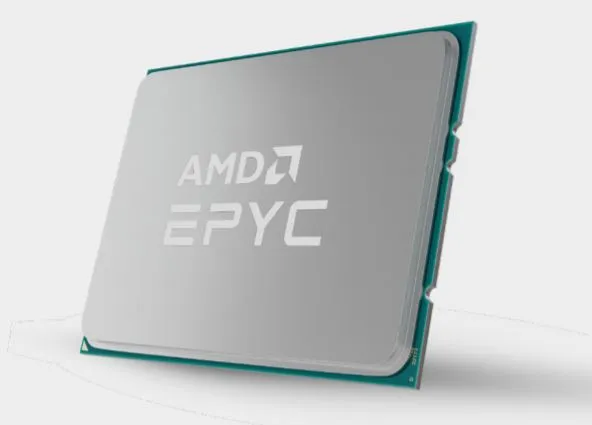1.Performance
Accelerate virtualized applications.
Keep business running fast with world-record performance1. AMD EPYC™ can deliver 2.3x more VMware vSAN™ performance than a comparable competitive offering2.
2.Security features
Help protect data with advanced security features
Help guard critical data with hardware-based security features only available in AMD EPYC™ processors. Isolate each virtual desktop to help defend it from many outside and internal threats.
3.Efficiency
Help reduce data center cost, power, and space
AMD EPYC™ can help reduce total cost of ownership (TCO) by up to 45% over three years.3 With more virtual desktop sessions per server, you can save on data center space, energy, and cooling.
4.Flexibility
“Right-size” your processing power
Buy only what you need to support your enterprise applications. AMD EPYC™ CPUs power both no-compromise one-socket and leadership two-socket servers.
5.Innovation
Optimize your current and future data center investment
AMD EPYC™ processors are optimized for the leading HCI solutions and software. Our long-term product roadmap can help you keep your IT investment on the path of continuous innovation
Technical Deep Dive
1. Leadership performance
• Maximize your HCI infrastructure capacity with up to 256 threads per 2-socket server that can deliver ~2.3x the VMware vSAN™ performance and virtual machine (VM) capacity compared to a comparable competitive published offering.3
• Using the same total number of cores in a server solution, an AMD EPYC™ 7F72 processor delivers ~25% more VMmark® 3.1.1 vSAN™ performance per core and ~17% additional tiles (VM workload capacity) than an Intel® Xeon® Platinum 8268 processor.4
• To support 1000 virtual desktop sessions, approximately 10 servers are required using two Intel® Xeon® Gold 5220 processors (36C) and only approximately five servers powered with two AMD EPYC™ 7F72 processors (48C). This can reduce three-year TCO by up to ~37%.5
2. Embedded security features
• Only x86 server processor with Secure Encrypted Virtualization (SEV).
• SEV encrypts and isolates VMs with unique encryption keys known only to the processor. • AMD Infinity Guard provides a modern multi-faceted approach to data center security with virtually zero impact on performance.6
3. VM density
• AMD EPYC™ with Nutanix™ can support up to ~450 VDI desktops on one 2x AMD EPYC™ 7742 processor-based server.7
• A 4-host server powered by two AMD EPYC™ 7742 processors delivers ~2.3x more VMmark® 3.1.1 vSAN™ performance and VM workload capacity than two Intel® Xeon® Platinum 8268 processors.
4. One- and two-socket
• AMD EPYC™ single-socket solutions, offering up to 64 cores, 8 memory channels and 128 PCIe® 4.0 lanes per CPU, with the AMD EPYC™ 7F32 delivering the best x86 floating point performance per core.8
• With up to 128 cores and 4 TB of memory, two-socket servers built with AMD EPYC™ processors can efficiently support the most demanding workloads.
5. Leadership solutions
• AMD has strong technology partnerships with major HCI solution providers including Dell, HPE and Lenovo.
• AMD EPYC™ is certified for VMware®, Nutanix™, Microsoft® Azure Stack HCI and SimpliVity.
AMD data center solutions

We are the undisputed market leader in CPU technology at a time when many businesses are modernizing their data centers.
That’s a responsibility we take seriously. It’s why AMD is strengthening its commitment to drive data center innovation now and far into the future. Our solutions are backed by long-term roadmaps for continuous technological advancement and ongoing optimization of your IT investment.
AMD is the ideal partner today and tomorrow. We deliver more choice and outstanding value with future-ready solutions that offer high performance, easy scalability, and reinforced security features. Learn more about AMD EPYC™ for your data center.
To learn more, click here.
Footnotes
1 For a complete list of world records see http://amd.com/worldrecords. ROM-169
2 4-node, 2x EPYC™ 7742 processor powered cluster with a score of 24.08@ 28 tiles on the VMmark® 3.1.1 benchmark using vSAN (https://www.vmware.com/content/dam/digitalmarketing/vmware/en/pdf/vmmark/2020-04-28-DellEMC-PowerEdge-R6525.pdf) delivers 2.27x more performance and 2.33x higher tile/VM workload capacity than the VMmark® 3.1.1 vSAN performance of a 4-node, 2x Intel Xeon Platinum 8268 processor powered cluster with a score of 10.63@12 tiles (https://www.vmware.com/content/dam/digitalmarketing/vmware/en/pdf/vmmark/2020-06-30-Supermicro-SYS-2029BT-HNR.pdf) as of 06/08/20. ROM-737
3 Comparison results calculated by AMD based on a hypothetical scenario hosting 3,200 virtual machines on 2-socket Intel Xeon 6242 16 cores ea. (32 total cores) based systems compared to 1-socket AMD EPYC™ 7702P 64 total core system, each VM (virtual machine) allocated one core, (1) 1 TB hard drive @ $387, and 8GB of DRAM with a cost of $16.41 per GB using 16GB DDR4 DRAM. All calculations are based on AMD’s best estimates of what actual costs and other values will be for both AMD and Intel based platforms.
Each AMD 7702P system supports 64 VMs and each Intel 6242 system supports 32 VMs, for a total of 50 AMD powered servers and 100 Intel based servers. These estimates do not include and VM server management costs. System Configurations: Intel Xeon based servers include (2) Intel® Xeon® Gold 6242 @ $2,529 ea, with 256 GB of memory, a dual socket 2U rack mount server, each with power supplies and NIC @ $2,500, for a total per server price of $12,146.56 ea. and a total hardware acquisition price of $1,214,656.
AMD EPYC™ servers include a single socket 2U rack mount chassis, with (1) AMD EPYC™ 7702P at $4,425, with 512 GB of memory, a single socket 2U rack mount server, each with power supplies and NIC @ $2,200, for a total per server price of $15,414.52 ea. and a total hardware acquisition price of $770,726. Power estimates: AMD 315 watts per server per hour, for a total solution power of 1360.8 kW per month for 50 servers. Intel 415 watts per server per hour, for a total solution power of 3585.6 kW per month for 100
servers. Three year total power with a PUE of 2 and a power cost of $0.12 per kWh: AMD – $97,977.60 and Intel – $258,163.20. Data center 3 year real estate cost estimates based on $20/mth/sq ft and 27 sq ft per rack are for: Intel is 5 rack cabinets at $97,200 and for AMD of $48,600 (2.5 rack cabinets). Server Administration cost is calculated with an estimate of $110,500 annually per server administrator (includes 30% burden) with a ratio of one server administrator per 30 servers resulting in Intel cost of $1,105,000 (for 100 servers) and for AMD $552,500 (for 50 servers) for total 3 yr server administration costs. Total estimated 3 Year TCO as a result is $2,675,019 for the Intel-based Systems and $1,469,804 for the AMD EPYC powered systems. As a result, AMD EPYC based systems are estimated to deliver up to a 45% lower TCO (excluding software costs). Annual cost per VM: (1469804/3200)/3=$279; (2675091/3200)/3=$153.This scenario contains many assumptions and estimates and, while based on AMD internal research and best approximations, should be considered an example for information purposes only, and not used as a basis for decision making over actual testing. ROM-329
4 4-node, 2x EPYC 7F72 processor powered cluster (192 total cores) with a score of 13.27@ 14 tiles on the VMmark® 3.1.1 benchmark using vSAN™ (https://www.vmware.com/content/dam/digitalmarketing/vmware/en/pdf/vmmark/2020-04-14-DellEMC-PowerEdge-R6525.pdf) delivers 24.8% more performance with a 16.7% higher tile/VM workload capacity than the VMmark® 3.1 vSAN performance of a 4-node, 2x Intel Xeon Platinum 8268 processor powered cluster (192 total cores) with a score of 10.63@12 tiles (https://www.vmware.com/content/dam/digitalmarketing/vmware/en/pdf/vmmark/2020-06-30-Supermicro-SYS-2029BT-HNR.pdf) as of 06/08/20. ROM-732
5 3-year TCO analysis based on AMD internal Login VSI 4.1.40.1 “knowledgeworker” profile on Microsoft Windows 10 Professional (build 1909) images testing as of 9/25/2020 and AMD Server Virtualization 3-year TCO Estimator tool v5.9 default assumptions. The analysis includes both hardware and virtualization software components. To support 1,000 Login VSI desktop sessions, the Intel Xeon Gold 5220 processor requires 10 ea. 2P servers for a 3-year TCO of ~$399 per user. The AMD EPYC 7F72 solution requires 5 ea. 2P servers for a 3-year TCO of ~$251 per user or ~37% lower TCO. Virtualization software pricing as of April 2020. Third party names are for informational purposes only and may be trademarks of their respective owners. This scenario contains many assumptions and estimates and, while based on AMD internal research and best approximations should be considered an example for information purposes only, and not used as a basis for decision making over actual testing. All pricing is in USD. ROM-744
6 AMD Infinity Guard security features on EPYC™ processors must be enabled by server OEMs and/or Cloud Service Providers to operate. Check with your OEM or provider to confirm support of these features. Learn more about Infinity Guard at https://www.amd.com/en/technologies/infinity-guard. GD-177
7 Based on AMD internal testing as of 9/25/2020 without hitting VSImax response time using Login VSI 4.1.40.1 “knowledge worker” virtual desktops on VMware vSphere 7.0 U1 and VMware Horizon 7.12 using VMware vSAN storage. ROM-739
8 Highest per core performance in the world based on EPYC 7F32 (8-cores) having the highest SPECrate®2017_fp_base score divided by total core count, of all SPEC® publications as of 4/14/2020. 1x EPYC 7F32 (8-cores) scoring 12.875 base result per core (103 SPECrate®2017_fp_base/16 total cores, www.spec.org/cpu2017/results/res2020q2/cpu2017-20200316-21228.pdf) compared to the next highest result 1x AMD EPYC 7262 (8-cores) scoring 11.54 base result per core (92.3 SPECrate®2017_fp_base/8 total cores, http://spec.org/cpu2017/results/res2020q1/cpu2017-20191220-20435.pdf) See www.spec.org/cpu2017/results for full ranking. SPEC® and SPECrate® are trademarks of the Standard Performance Evaluation Corporation. Learn more at www.spec.org ROM-570










![Read more about the article [Funding alert] SaaS startup Rattle raises $26M Series A funding led by Insight Partners](https://blog.digitalsevaa.com/wp-content/uploads/2022/04/Rattle-1649138437639-300x150.jpeg)
